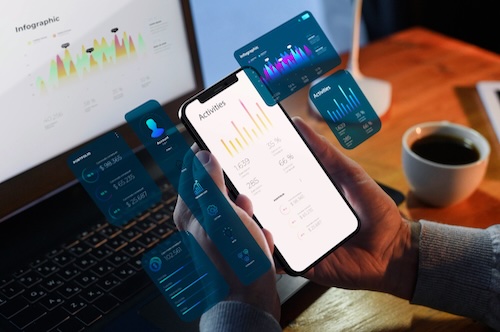Influencer marketing is a billion $$$ industry, with marketers globally expected to spend more than $32 billion on creator collaborations in 2023. It is an organic ecosystem of its own, thriving with inspiration and creativity, connecting millions of like-minded consumers across the globe and fostering trust between a brand and its target audience. However, it is challenging for brands to stay on top in such a fluid environment.
You see, every action an influencer commits is always under the watchful eye of their audience, and it takes one wrong step for a trendsetter to become a pariah. Follower growth and engagement rates are always changing, which gives brands more room for making errors, like collaborating with a fake influencer.

What’s the solution? The key to success lies primarily in analytics. It means you need to be measuring the Key Performance Indicators (KPIs) for your influencer marketing campaign. 49% of customers depending on recommendations from their favorite influencers before making purchases. Thus, measuring KPIs for your influencer marketing campaign can help you reach more target prospects, garner better engagement, and drive more sales and revenue that supercharges business growth.
But it doesn’t end there! The next few questions that may come to mind are—which KPIs should I account for? How do I track them? Which tools, methods, and strategies should I use? If you are wondering how to measure influencer marketing success by tracking vital campaign KPIs, you should definitely read this blog. We will provide you with answers to all of this and more in this informative article.

Why are KPIs Important in Influencer Marketing Campaign?
Yes, influencer marketing is a rising trend, with an overwhelming 93% of marketers worldwide vouching for its effectiveness as a marketing strategy. However, the good is always accompanied by some bad. Research indicates that many companies have suffered huge financial losses totaling $1.38 billion, by investing in influencers with inflated fake follower bases.
This is why it is very important to define key performance indicators (KPIs) for your influencer marketing campaign. Without knowing which metrics truly indicate success, you may end up engaging in collaborations that bring you fake engagement but no revenue.
Benefits of Measuring KPIs in Influencer Marketing
Here are three vital advantages of defining KPIs in influencer marketing:
- Improves performance evaluation and ROI assessment
- Enables you to optimize influencer campaigns
- Helps you compare and benchmark creators
Let's Deep Dive into These Key Aspects -
1. Improves performance evaluation and ROI assessment
Defining KPIs at the beginning of your creator collaboration will allow you to analyze the effectiveness of your marketing efforts accurately.
This includes understanding how many followers the campaign helped you gain, evaluating the quality of engagement your brand registered, and calculating how much revenue the partnership brought in.
Monitoring KPIs also enables you to evaluate your influencer marketing ROI. You may assess the financial impact of the campaign and ascertain its cost-effectiveness by monitoring KPIs like conversions, sales, website traffic, or social media engagement.
Ultimately, KPIs help you in making data-driven marketing decisions that impact your brand’s reach, reputation, and bottom line.
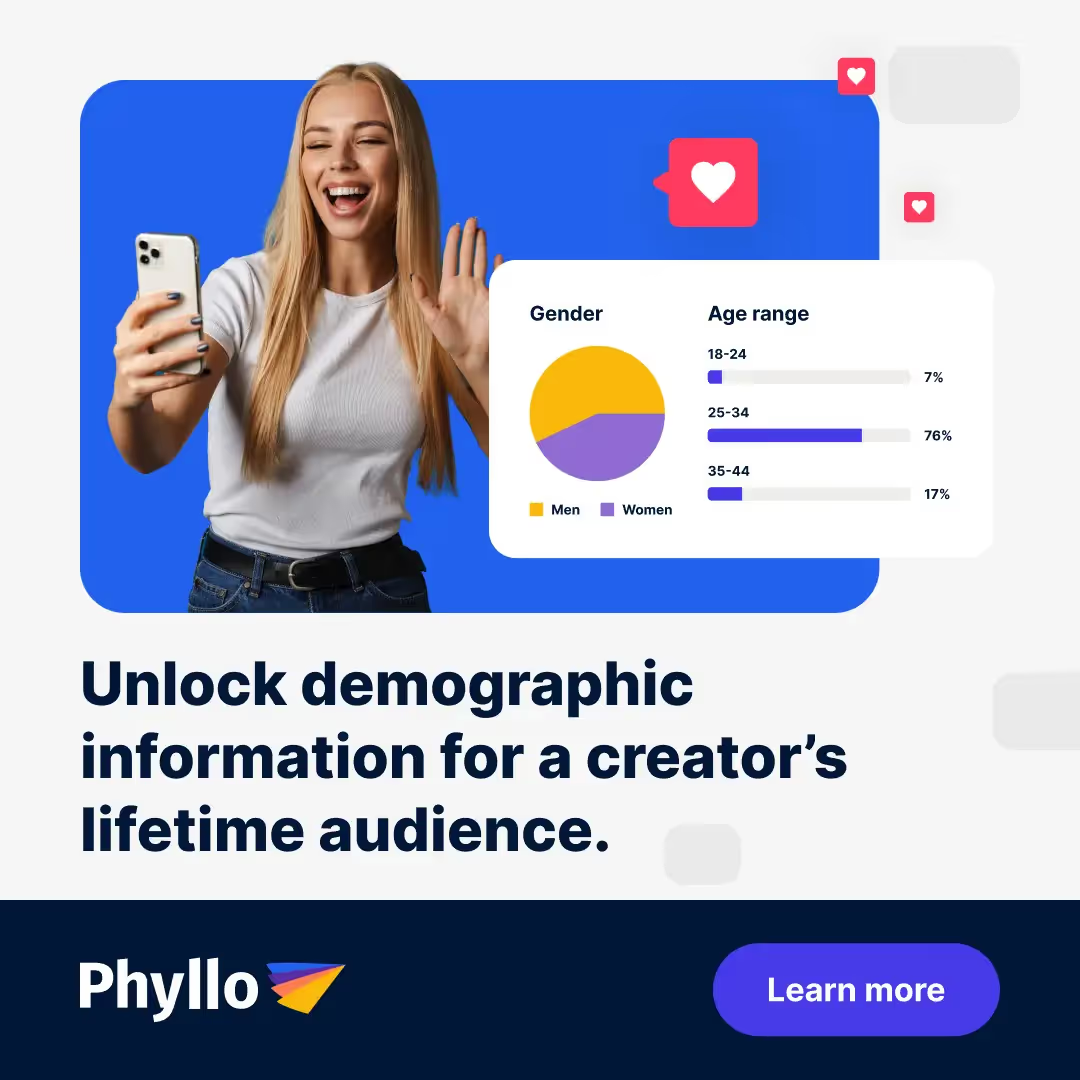
2. Enables you to optimize influencer campaigns and collaborate with the right influencers
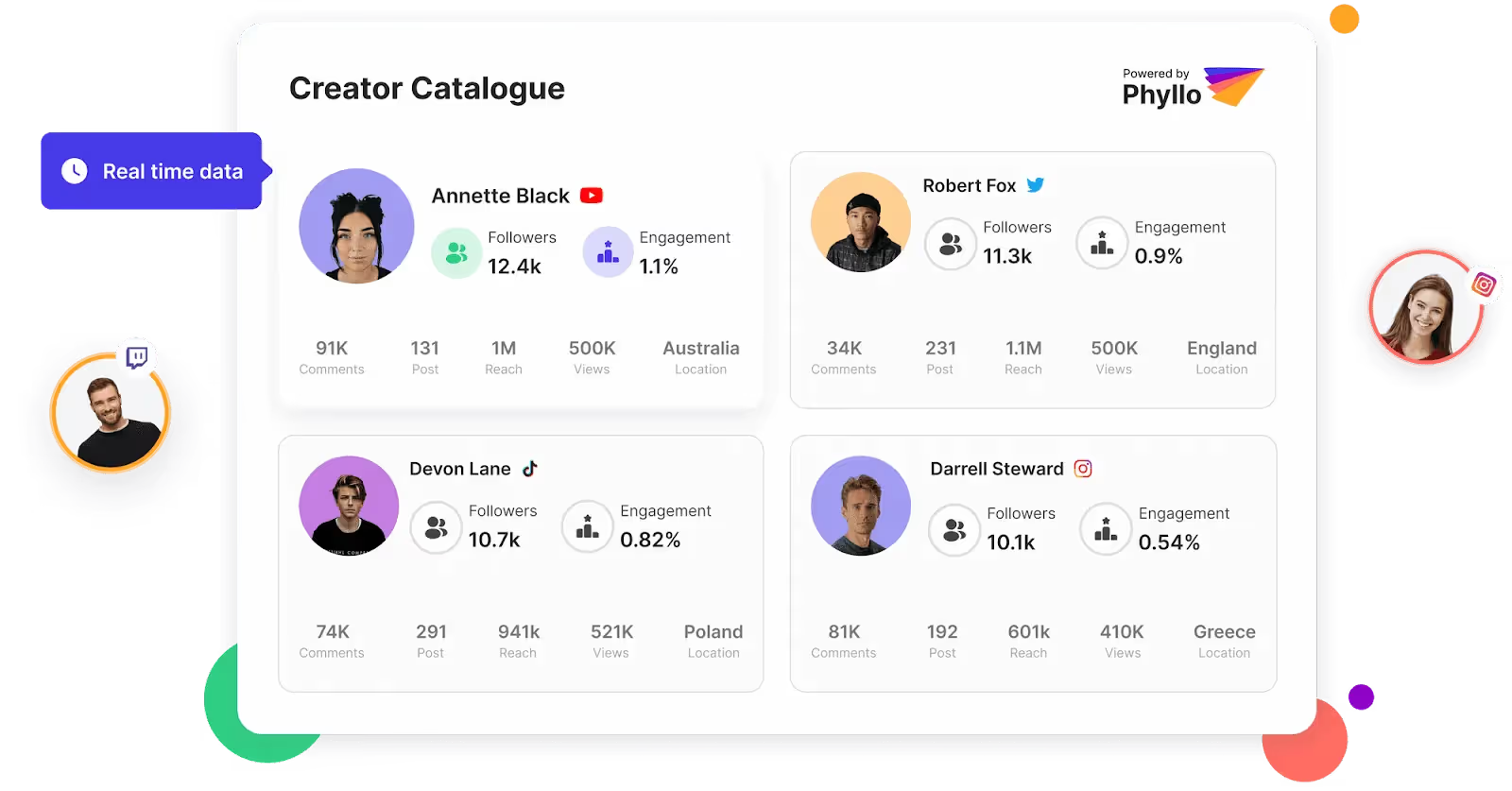
There are two reasons why your influencer partnership may not be going as planned—either the audience might not like the content you’re creating, or you are collaborating with an influencer unsuited to your brand.
Let’s explain this with an example. If you run a skincare brand and your influencers are either creating content that does not focus on sustainable and chemical-free products or are primarily into experimental makeup looks—your collaborations are unlikely to generate your desired outcomes.
This is where measuring KPIs can be a game-changer! You may determine what is working well and needs improvement by looking at KPIs like reach, impressions, click-through rates, or audience demographics. You can then use this information to improve your methods, target the proper audience, and optimize your content with the goal of generating better results.
When selecting the right influencer for your brand, KPIs like follower growth, engagement rates, and audience demographics can help you make informed decisions and connect with suitable creators aligned with your campaign objectives, primed to help your brand reach and engage more target buyers.
3. Helps you compare and benchmark creators
Tracking KPIs enables you to evaluate and contrast the effectiveness of various influencer marketing initiatives. You can spot patterns, trends, and best practices that produce great results by tracking and analyzing data from numerous campaigns.
You can then use this knowledge to improve your strategies, invest your resources wisely, and establish reasonable objectives for upcoming influencer campaigns.
Moreover, knowing which creator collaborations generate better results means you can collaborate with them repeatedly over time, such that they turn into your brand ambassadors, and their followers turn into your loyal customers.
Now that you know the benefits of measuring KPIS for your influencer campaigns, let’s dive into the top five categories of influencer marketing KPIs you should account for.
Top 5 Categories of Influencer Marketing KPIs You Must Measure for Your Influencer Campaign
Here are the top five categories of influencer marketing KPIs you must measure for your next influencer campaign:
- Brand Awareness
- Social Engagement
- Click-through Rate (CTR)
- Website Traffic
- Conversions & Sales
1. Brand awareness
Increasing brand awareness is typically one of the top goals of influencer marketing.

Influencers have their brand reputation, and those with core values that align with your brand’s will most likely have a follower base that will be highly interested in your products. Not to mention, successful creators have an ever-growing audience, which means every day, you can engage new prospects who may have never heard of your brand before and easily foster trust amongst them, by milking their positive sentiments toward their favorite influencer.
Under brand awareness, here are some notable metrics you should account for:
- Reach: Reach is the proportion of your target market with at least one exposure to the influencer's content. For the influencers driving more people to your business, you can offer them a product discount code to promote your brand.
- Impressions: To get an audience to interact with a brand, they must be made aware of its existence and offerings. Based on your social media statistics, impressions represent the number of times consumers were exposed to the influencer's content.
- Audience growth: Following influencer participation, you may see a rise in new followers for your company. This is another sign that the campaign is successful. This can be evaluated by counting the number of people who started following you after viewing your sponsored content on the channels of the influencers you have picked for your influencer campaign.
Other KPIs you can measure include brand and hashtag mentions, number of views (if the content is in video format), and number of Google searches.
Related Read: What is Brand Safety? Why is it Important?
2. Social engagement
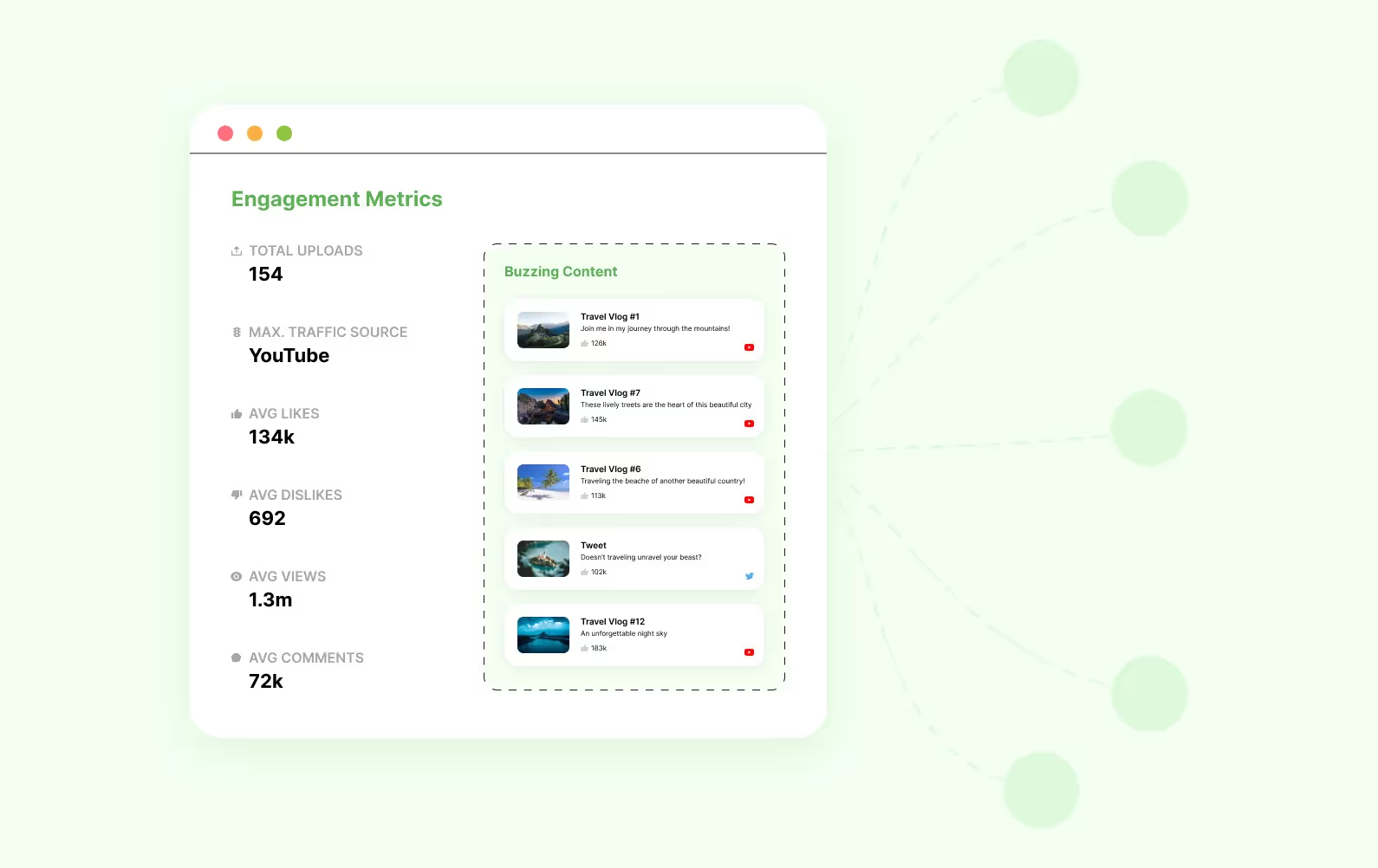
Social engagement is the top indicator of a creator’s influence. It is usually hard to identify (without using influencer analytics tools) if the influencers boasting a huge follower count are the real deal, or simply have inactive, or worse, bot followers. Engagement rate kills that myth, and can give brands real insights into what percentage of an influencer’s brand is actually seeing and interacting with their content.
A recent study showed that influencers with a follower count between 1000-5000 have the highest engagement rates, averaging at about 4.38% while those with follower counts between 100000 and 1000000 have engagement rates of 1.06%. Information like this can really help companies make informed decisions about who they are partnering with for growing their brand.
Under social engagement, here are some notable metrics you should account for:
- Likes: Since users don't even need to read the content or take notice of the minute details to click the like button, the quantity of likes does not necessarily reflect their level of interest. It nevertheless highlights promise.
- Comments: Users take a moment to write a brief note to the author at this point. This interaction shows that readers are engaged in the subject. On the other hand, telegrammic comments are now the norm. Smiling, saying hi, and other common comments don't add much value for brands and influencers.
- Shares: These also include reposts and retweets—all important endorsements that show a post is successful. Such engagement with the content shows that people thought it was worthwhile to recommend it to their friends. This tactic is frequently used by social media users as a means to save the post for later, which also shows interest.
Ultimately, all of this indicates follower behavior. Positive sentiments that users exhibit by commenting and sharing an influencer’s content indicate that the latter is really resonating with their audience.
Read Also: Guide on Social Media Listening & Monitoring API
3. Click-through Rate (CTR)
The click-through rate (CTR) measures how frequently a prospective customer clicks on a specific link in a sponsored post. With tools like Google Campaign Manager, you may assign specific custom links and UTM tags to your influencer campaign.
You can then use these to track each influencer’s campaign performance separately. You may also make custom URLs for Instagram Stories, bios, and ads to test what kind of content works best. Additionally, optimizing your content, such as ensuring the Instagram reel size meets platform guidelines, can enhance visibility and engagement.
Keeping tabs on your CTRs is crucial. If consumers aren't landing on your website, it may be because of your messaging, call-to-action (CTA), or ineffective targeting. A high CTR suggests that more people view your website, eventually pushing them down the sales funnel toward purchasing your products.
4. Website Traffic
For businesses that have a website to showcase their products, it is imperative for their influencer marketing campaigns to drive people to the site. With tools like Google Analytics, you can now track which campaigns and sponsored posts from which influencers are driving the highest number of visitors to your website. This is all thanks to UTM parameters, which are little snippets of unique codes attached at the end of your web page’s link, which record such information.
While page views are important when it comes to website traffic, it is recommended to measure the number of unique visitors coming to your site from an influencer’s post, to better understand how wide your campaign reach is. To determine the impact of your future campaigns, you can also benchmark the traffic and users of your website before and after working with the influencer.

You may also track referral traffic to your website from an influencer’s campaign to guage your marketing success. To promote continued referral traffic, you may ask the influencer to share a URL with followers on their blog, website, or through social media channels like Instagram stories or LinkedIn. As soon as one of their followers clicks on the link to access the webpage on your site, Google Analytics can record it as a referral visit. This may be quantified, allowing you to observe the influence.
5. Conversions and Sales
Conversions don’t necessarily mean sales in this case. Depending on your marketing objectives, it could be sales, subscriptions, downloads, and email sign-ups. Analyzing which influencer, platform, or content piece is producing the most conversions is crucial when measuring conversions. This might assist you in investing in the proper channels for future conversion rate improvement.
Conversions are concrete actions that frequently result in financial gain. This is why 42.3% of marketers reportedly use conversions and sales to gauge the effectiveness of their influencer marketing program.
Under conversions and sales, here are some notable metrics you should account for:
- Leads and opportunities: This is not a very tangible outcome, but an equally important metric to measure. Knowing how many new leads or prospects entered your sales funnel from an influencer’s post gives you an idea about your campaign’s reach, aids you in determining whether collaborating with that influencer was a good decision, and how much you should be paying them for their efforts.
- Sales: You can start by calculating the amount of money you made as a result of converting existing prospects from your influencer marketing. Let's say you go above and above to offer influencers content to work with, such as by requesting them to include a promotional offer for their audience or by supplying free goods or samples for reviews or testing. In that situation, you can gauge how many actual sales occurred throughout a specific time frame.
- Average order value (AOV): By gauging the average value of the purchases an influencer’s followers are making from your sponsored post, you can figure out how much the influencer is contributing to your bottom line. Doing this can help you in deciding how frequently you should collaborate with a creator and how much you should pay them for each partnership, eventually helping you increase your profits over time.
You can measure conversions and sales KPIs using promo codes, affiliate links, and UTM links.
How to Set KPIs for Influencer Marketing Campaigns?
Before choosing which influencer marketing metrics or KPIs you would like to measure for your influencer marketing campaigns, you need to be clear about what goals you wish them to serve. Here are three steps you can follow to do this:
1. Determine clear and measurable goals at both the micro and macro levels
Most marketers publish a marketing campaign without a clear goal, as to what they want it to achieve. Big mistake—that can cause your brand time and money! It is recommended that before you set up an influencer marketing campaign, you decide what you want it to achieve. This could range from driving brand awareness to acquiring more customers. But it needs to be well-defined.
You can start by following the SMART method to define your goals to do it right. SMART here stands for —
- Specific
- Measurable
- Achievable
- Relevant
- Time-bound
Let’s explain this with an example. Suppose you want 60% of your Instagram followers to see your new product launch. With an audience base of 20k followers, this number comes down to 12000 followers. So, now you have a specific goal in mind—which helps you make targeted strategies. You have to generate 12000 impressions on your posts. For that, you can choose to collaborate with 4-6 mid-tier, macro, or even micro influencers, in favor of 2-3 mega influencers. Since your target isn’t too large, it may be easily achievable by having smaller influencers promote it to their engaged audience base, saving you money for other marketing initiatives if you need them later.
2. Select KPIs that directly tie into your influencer marketing goals
Many influencers boast vanity metrics, but only a few truly succeed at engaging their audience. You will not see any progress toward your influencer marketing goals unless you collaborate with the right people.
This is why it is important to choose the right KPI metrics. Here are a couple of examples:
- Engagement rate: A big audience base only means so much. A mega-influencer can have 10x the audience base of a micro-influencer, but if the latter shows a 4x more engagement rate, that is who you should invest in.
- Spend efficiency KPIs: Without knowing how much each impression or engagement costs you, you cannot know whether the $$$ you are spending is truly helping you achieve your business outcomes. Focus on these metrics to know if paying influencer A more than influencer B is actually worth it.
Disclaimer: A large follower count shouldn’t determine compensation for influencers; growth-driving metrics should.
3. Break down your influencer marketing goals and KPIs at the end of a campaign
This is the most underrated step—analyzing and breaking down the results generated from your influencer marketing campaigns. You need to be able to honestly take credit for the right and wrong in order to plan for better results in the future.
- Is it possible that your poor strategy prevented you from achieving a goal? Or weren't you monitoring the appropriate KPIs to guide you in the proper direction?
- How can you use that best practice in your next campaign if you exceed your goals? And how could you improve the next time by setting more challenging goals?
Understanding your performance and using data to inform the core of your influencer marketing plan are the only ways to maximize your profits from creator collaborations.
In the following section, we will highlight some tools and methods that may be useful in monitoring and measuring influencer marketing KPIs.
Tools and Methods to Track and Measure Influencer Marketing KPIs
Tracking and measuring influencer marketing KPIs may not be easy, but there are several tools that can help you achieve your objectives. These include Google Analytics, promo codes and custom trackable links, affiliate marketing software, and social listening and hashtag monitoring tools, and many more. However, we have highlighted the three most widely used categories of influencer marketing tools and methods used to track campaign KPIs:
1. Social media analytics tools
These include tools such as Facebook Insights, Instagram Insights, and software for extracting Twitter analytics, LinkedIn analytics, and YouTube analytics. They offer comprehensive information on interaction, reach, impressions, follower growth, and other crucial indicators. You may use these tools to keep tabs on how well your influencer marketing initiatives are doing on particular social media networks.
Examples include Hootsuite, Sprout Social, SHIELD, etc.



2. Influencer marketing platforms
There are a number of platforms for influencer marketing that provide tools for tracking and evaluating KPIs. These platforms offer information on KPIs such as campaign reach, engagement, impressions, and occasionally even conversions.
Examples include Upfluence, Traackr, etc.

3. Built-in platform analytics
Tools that provide you insights into company and business accounts are offered by several social media networks. These insights offer important information on the audience's demographics, engagement levels, impressions, and other factors. These platforms can also be used to generate custom reports that combine data from many sources, and use spreadsheet programs like Microsoft Excel or Google Sheets. Identify trends, patterns, and correlations between influencer campaigns and desired KPIs using data analysis. Utilize the power of native influencer marketing analytics tools offered by websites like Instagram Insights, Facebook Page Insights, or LinkedIn Analytics.

Best Practices for Analysing Influencer Marketing KPIs and Metrics
Lastly, let’s look at some best practices you should follow while analyzing influencer marketing KPIs and metrics:
1. Segment your data by influencers and campaigns
Examine your KPIs at the level of each influencer and each campaign. To identify which influencers and campaigns generate the required effects, evaluate each one's effectiveness separately. This will benefit your resource allocation, content tactics, and influencer selection.
2. Favor engagement KPIs over follower counts
Most influencers are active on multiple channels, but your product may target only one aspect of their niche. For example, gamers are not very active on social media channels, but you can find them in hordes on streaming platforms.
This is why retro gaming platform Antstream Arcade partnered with niche gaming streamers on Twitch for influencer marketing and ended up gaining more than 250000 followers and registering an overwhelming 1300% growth in 2021.
3. Deep dive into audience insights
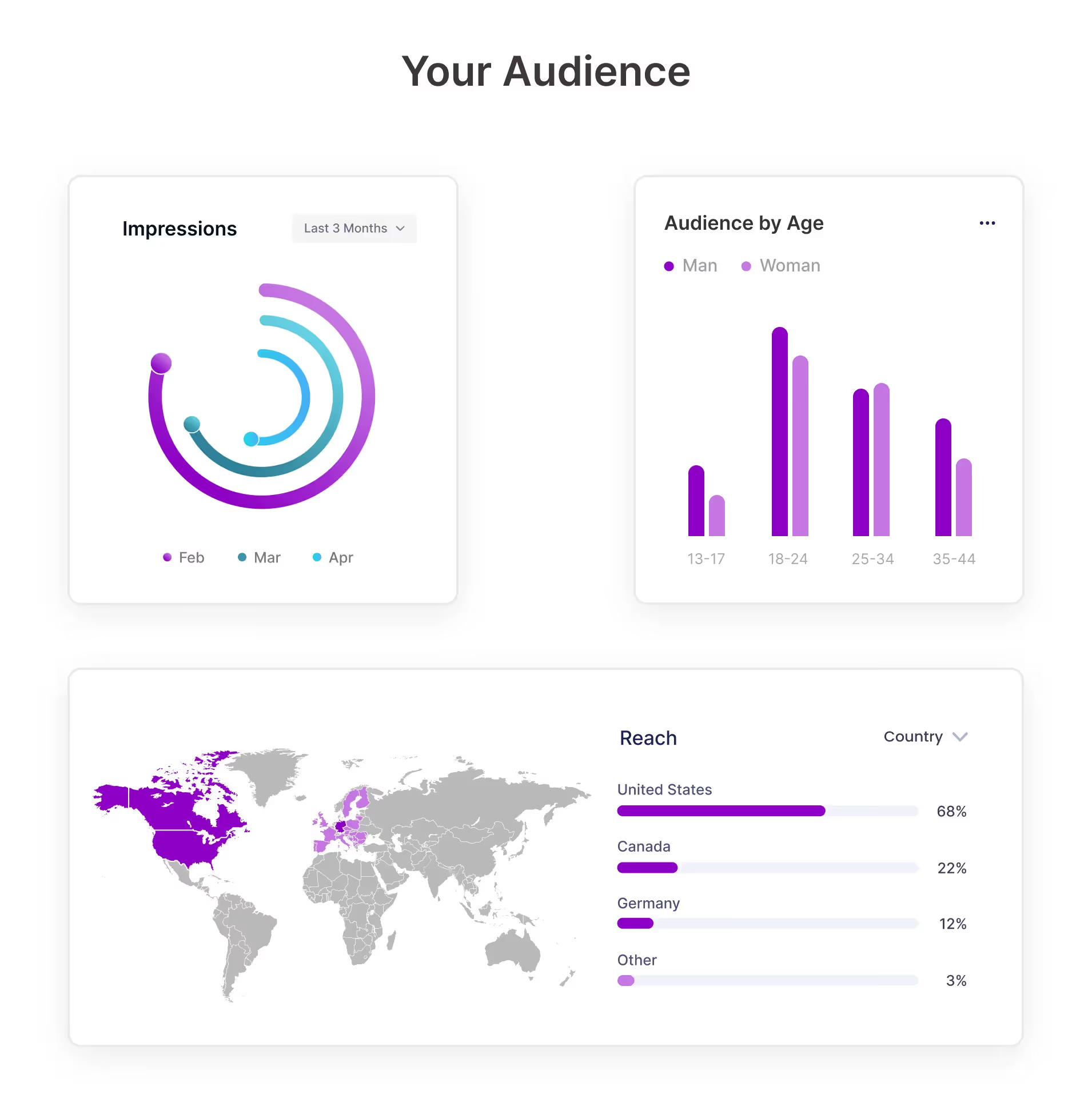
Analyze the audience information related to your influencer marketing initiatives. To determine whether the influencer's audience is similar to your target market, look for trends in demographics, hobbies, and behaviors. Look into the specific influencer traits, campaign themes, or content kinds that regularly provide good outcomes. By using these insights, successful strategies can be repeated and ineffective ones can be avoided.
4. Don’t fall into the trap of vanity metrics
Reach, impressions, and follower numbers are all crucial metrics, but they don't necessarily paint a whole picture of a campaign's effectiveness. Analyze more in-depth interaction analytics, such as click-through rates, likes, comments, and sales. These metrics provide information on audience participation and campaign impact.
Another important KPI can be your website traffic. If your products are listed on a website, tracking which influencer initiatives on which social media channels are contributing to increasing your site traffic is super important. For instance, Leesa, a luxury mattress site, was able to drive 100000 website clicks by sponsoring influencer collaborations with certain YouTube creators.
5. Account for both qualitative and quantitative analyses
It is recommended that you don't disregard qualitative analysis even when quantitative data offers numerical insights. Integrate customer, influencer, and other stakeholder input to learn more about your efforts' effectiveness. The context that qualitative insights provide might be used to explain trends or anomalies found in your quantitative investigation.
That’s it! Go forth and conquer! And if you are looking for an all-encompassing tool that powers your influencer marketing strategies across multiple popular social media channels with 100% trusted and authentic creator data, try Phyllo!
How Phyllo Helps in Setting Up & Measuring KPIs for Influencer Marketing Campaigns
Phyllo is an influencer marketing analytics tool that provides authenticated and open influencer data directly pulled from social media networks like Instagram and Facebook.
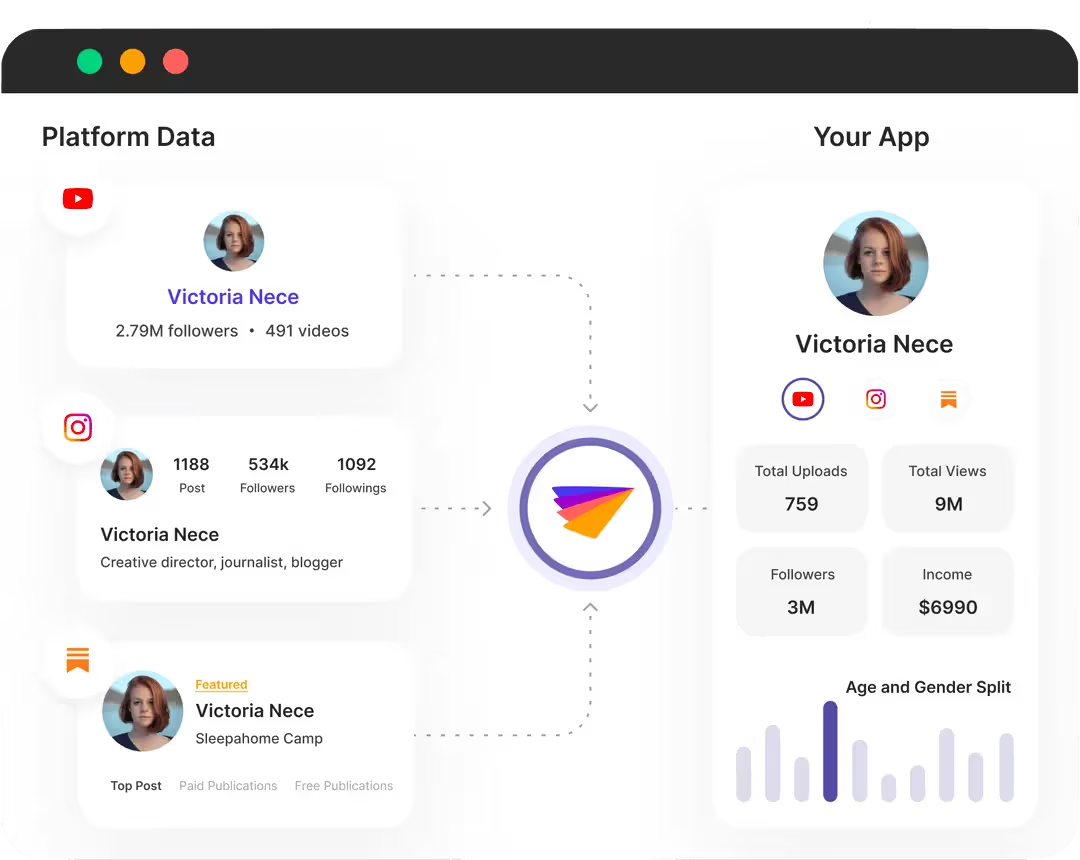
The Influencer Marketing solution from Phyllo removes infrastructure costs for marketers who work with numerous influencers across several social media platforms. You must develop APIs from several social media platforms to obtain reliable and recent data. But creating, managing, and maintaining many APIs while scaling them as needed is difficult.
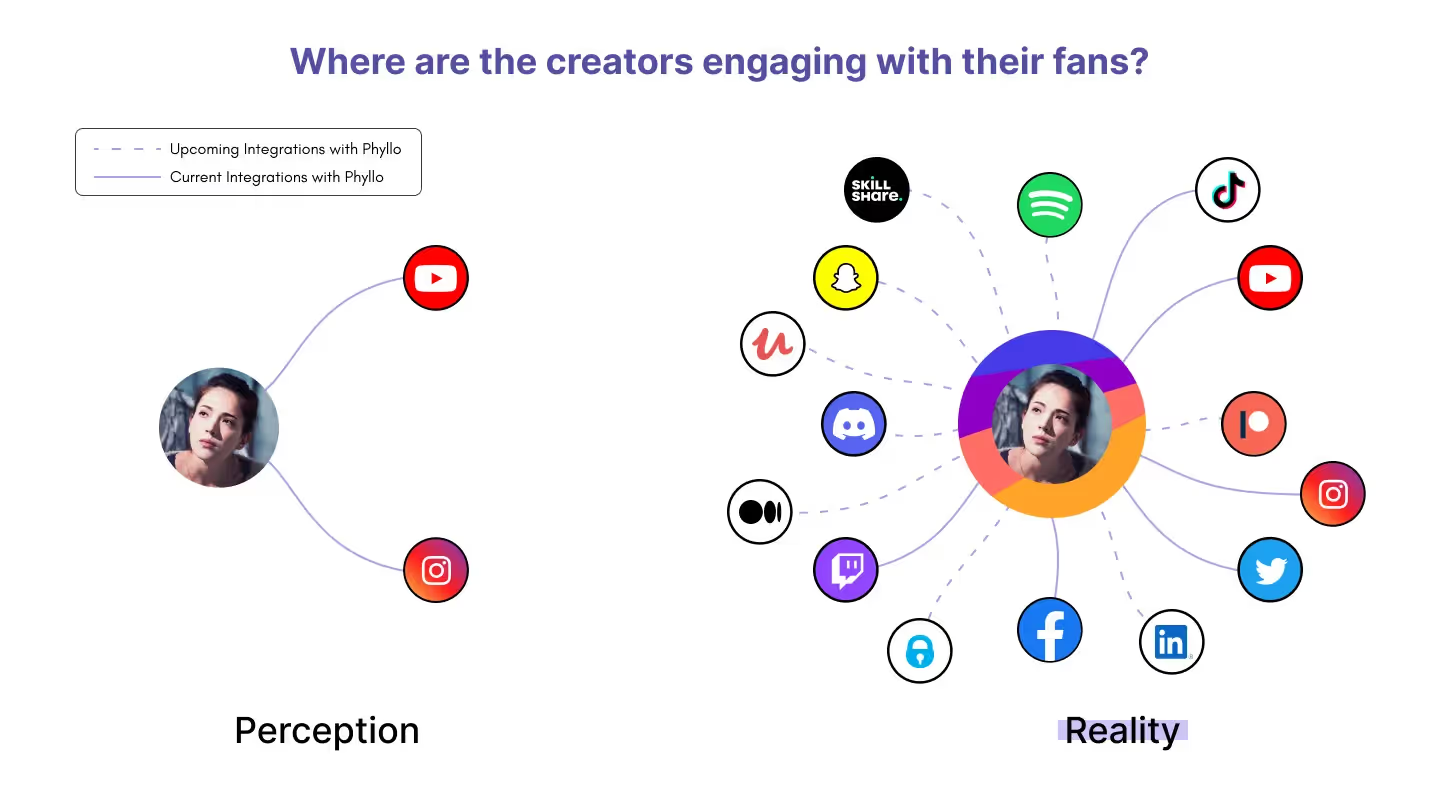
Phyllo handles these issues in a single sweep, and you can use their single universal API to obtain influencer data across several platforms.
Here is what you can do with Phyllo:
- Instantly onboard influence from any social media platform, with zero manual interventions
- Group influencers based on their niche for brand partnerships and affiliate marketing
- Measure KPIs like follower counts, engagement rates, ROI, and more to gauge the success of your campaigns in real-time
- Analyze the content performance of paid and sponsored posts on multiple social media platforms
- Smooth over communications with creators by allowing you to access their data (via. Phyllo Connect SDK)
Also read: How Beacons uses Phyllo to create the perfect media kit for creators to be successful
Want to know more about Phyllo and how it can help you set up and track influencer marketing KPIs? Sign up for your live demo here and explore all its features today!









